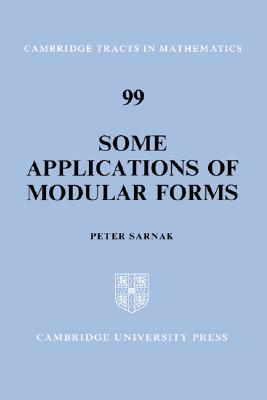

 |

|

The average rating for Some applications of modular forms based on 2 reviews is 3 stars.
Review # 1 was written on 2013-12-01 00:00:00 Mark Parkyn Mark ParkynThis did not stay relevant Furlong... Sorry, couldn't help myself. But, no, seriously—this text did not age well, in spite of its extensive referencing and data use. It's a commentary on youth participation in politics from way back when we were still trying to act like capitalism and democracy under capitalism isn't a complete trainwreck. You'll find yourself being really frustrated by the things that are used to measure young people's involvement in politics and the accompanying analysis. It's a good text if you need to reference reasons for why the young people of today have decided to take to entirely different political platforms (literally; thank you Youth Strike for Climate) outside of the mainstream establishment, but don't expect much incisive thought on as to why that might be... (Like, for example, the way mainstream political institutions exclude most people under the age of 25 from any real opportunity to drive for change). |
Review # 2 was written on 2012-01-18 00:00:00 Goroon V Munroe Goroon V MunroeHaving set out to improve my knowledge of English history, I'd come across references to this book as a seminal study of the English families and life before the Industrial Revolution. Professor Laslett provided a finely researched, nuanced, and rather well-written portrait of its subject. It is highly recommended. In all of these areas, Laslett demonstrated how common assumptions about the lives of the average English family had been incorrect, and opens a door into studying the lives of the average and poor of England, rather than only the lives of the wealth, priviledged, landed, and literate upper crust. By way of a brief background, Laslett captures significant early research from the Cambridge Group on Population and Social Structure. First published in 1965, The World We Have Lost inspired the growth of research on family history, demography, and other topics. The book was path-breaking, at a time when English historians rejected the very practice of quantitative social history. Always cautious and emphasizing the preliminary nature of his conclusions, the book remains a foundational text. I will mention a few of his conclusions. First, the nuclear family was the dominant form of household (by number) in England before 1700. Second, most couples not only married in the later 20s, but they also actually had only a few children on average than most people today assume. Third, in wealthier families, people were able to marry earlier (due to economic means), lived longer lives, and had more children, though infant and childhood mortality still took an awful toll. Next, for the large majority of Englishmen, their lack of physical mobility and lack of literacy limited the scope of the view of the world. They probably never traveled very far from the village where they were born, perhaps five to ten miles. In this sense, England as a political entity, was really the province of and under the control of that quite small elite. Thus, a sizable majority lacked the frame of reference to seek to challenge as unjust their political and economic situation, while the small, landed, educated, and wealthy elite often gained access to a broader perspective through a combination of education, travel, ongoing reading, and interaction with people with similar access. Fifth, many children of lower order families were employed as servants in husbandry (farm laborers) at an early age in a more wealthy households headed by land owners. In such situations they often remained until finally able to marry in their mid to late 20s. We should also note that farming, either on one's own land, as a tenant, or as a farm laborer was by far the most common mode of livelihood, and that the popular memory of the commonness of skilled trades was actually not accurate. Seventh, despite this delayed pattern of marriage, there were really comparatively few out-of-wedlock births. This fact may well testify to the strength of social norms based on both religious beliefs and the fact that it was readily possible to have outstripped the supply of food which could be grown. However, the fact of a substantial percentage of births coming less than 9 months after the formal wedding, but after the formal betrothal (engagement) (along with other evidence) suggests that it was socially accepted that a couple might well become intimate in this short interlude between the betrothal and wedding ceremony. I could explore several more topics, but will leave that for your enjoyment. I enjoyed the book quite well and find myself much more informed about The World That We Have Lost. . |
CAN'T FIND WHAT YOU'RE LOOKING FOR? CLICK HERE!!!